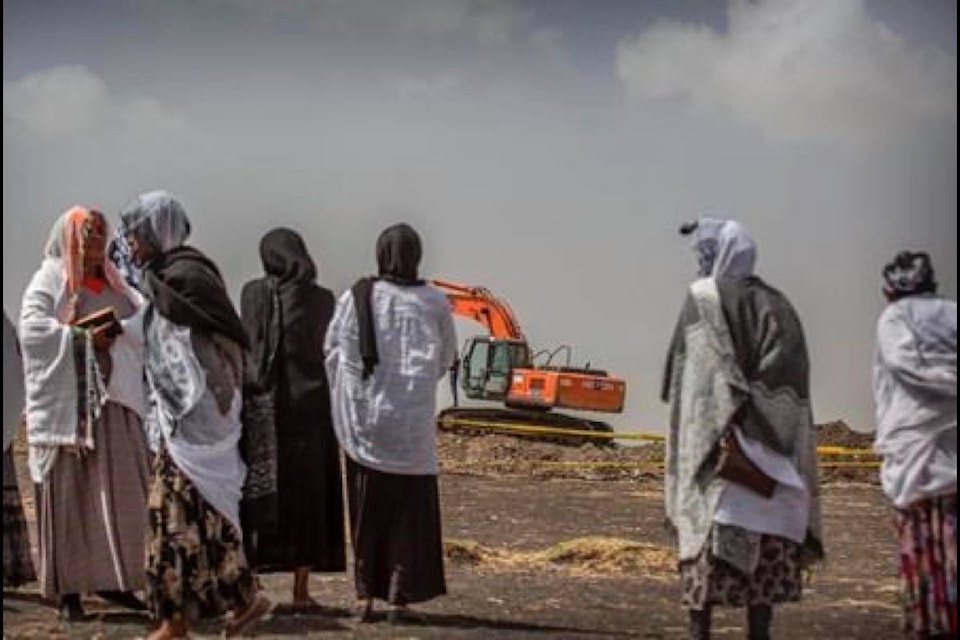Analysis of the flight recorders of the crashed Ethiopian Airlines plane has begun, the airline said Friday, and The New York Times reported that the pilot requested permission “in a panicky voice” to return to the airport shortly after takeoff as the plane dipped up and down sharply and appeared to gain startling speed.
The report cited “a person who reviewed air traffic communications” from Sunday’s flight saying controllers noticed the plane was moving up and down by hundreds of feet.
An airline spokesman has said the pilot was given permission to return. But the plane crashed minutes later outside Addis Ababa, killing all 157 on board.
French authorities now have the plane’s flight data and voice recorders for analysis. They have said it was unclear whether data could be retrieved. The data recorder appeared to show damage. Ethiopian Airlines said an Ethiopian delegation led by its chief accident investigator had arrived in Paris.
In Ethiopia, officials started taking DNA samples from victims’ family members to assist in identifying remains. The dead came from 35 countries.
Countries including the United States have grounded the Boeing 737 Max 8 as the U.S.-based company faces the challenge of proving the jets are safe to fly amid suspicions that faulty software might have contributed to two crashes that killed 346 people in less than six months.
READ MORE: Canada bans Boeing 737 Max 8 plane following fatal Ethiopian crash
The decision to send the flight recorders to France was seen as a rebuke to the United States, which held out longer than most other countries in grounding the jets. The U.S. National Transportation Safety Board sent three investigators to help French authorities.
Boeing executives announced that they had paused delivery of the Max, although the company planned to continue building the jets while it weighs the effect of the grounding on production.
The U.S. Federal Aviation Administration in grounding the planes said regulators had new data from the satellite-based tracking that showed the movements of Ethiopian Airlines Flight 302 were similar to those of Lion Air Flight 610. That flight crashed into the Java Sea off Indonesia in October, killing 189 people.
Boeing said it supports the grounding of its planes as a precautionary step, while reiterating its “full confidence” in the safety of the 737 Max. Engineers are making changes to the system designed to prevent an aerodynamic stall if sensors detect that the jet’s nose is pointed too high and its speed is too slow.
Satellite-based data showed that both the Ethiopian Airlines and Lion Air planes flew with erratic altitude changes that could indicate the pilots struggled to control the aircraft. Both crews tried to return to the airport.
The Max is the latest upgrade to the Boeing 737s. Because its engines were larger and heavier, they were placed higher and farther forward on the wings. That created concern that the plane might be slightly more prone to an aerodynamic stall if not flown properly, so Boeing developed software to prevent that.
Investigators looking into the Indonesian crash are examining whether the software automatically pushed the plane’s nose down repeatedly, and whether the Lion Air pilots knew how to solve that problem.
Ethiopian Airlines says its pilots received special training on how to deal with the Max’s anti-stall software.
At the crash site in Hejere, about 50 kilometres (31 miles) from Addis Ababa, searchers continued to pick through the debris. Blue plastic sheeting covered the wreckage of the plane.
Anxious family members began giving DNA samples and waited for news on when identification of remains would begin. Members of Israel’s ZAKA emergency response team were granted access to the site and were doing forensic work.
READ MORE: Pacific Rim National Park mourns loss of ‘bright star’ killed in Ethiopian crash
READ MORE: Anguished families of Ethiopian plane crash victims find nothing to bury
Canada’s ambassador to Ethiopia, Antione Chevrier, told The Associated Press that discussions on repatriation of remains would begin once the identification process begins to yield results. “The next steps will take some time,” he said. Canada lost 18 people.
“We are not told what they have found so far,” Ethiopian citizen Faysal Hussein, whose cousin was killed, told the AP. “We are sitting here like forever. We were taken to the crash site on Wednesday but not allowed to get a closer look.”
A Kenyan citizen, Pauline Gathu, lost a brother.
“We were expecting that we will have our body well-kept but we are amazed to hear that there is nothing, totally nothing,” she said. “And people are waiting for us to give them reports of what we have found but we don’t have words, we don’t know what to do.”
___
Meseret reported from Addis Ababa. Associated Press writers Isabel DeBre in Jerusalem, Dave Koenig in Houston and Tom Krisher in Detroit and video journalists Josphat Kasire and Desmond Tiro contributed.
___
Elias Meseret And Mulugeta Ayene, The Associated Press
